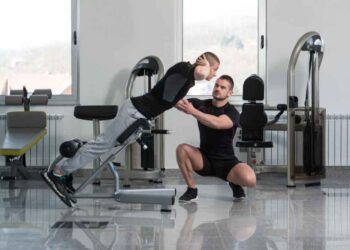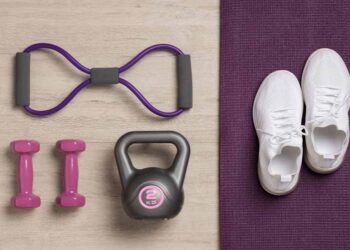Are you looking to strengthen your lower back and glutes? Are you tired of dealing with back pain and poor posture? Look no further than hyperextensions, a powerful exercise that can unlock your potential for a stronger back and improved overall fitness.
Hyperextensions, also known as back extensions, are a key component of any lower back workout routine. They target the posterior chain, including the lower back, glutes, and hamstrings, helping to build endurance and stability. But that’s not all – reverse hyperextensions provide the additional benefits of spinal decompression and rehabilitation, enhancing core strength and activating the gluteal muscles.
Key Takeaways:
- Hyperextensions are a powerful exercise for the lower back and glutes.
- They help build endurance, stability, and core strength.
- Reverse hyperextensions offer added benefits like spinal decompression and glute activation.
- Proper form and technique are essential for maximizing the benefits of hyperextensions.
- Hyperextension variations and equipment can add variety and challenge to your routine.
Benefits of Hyperextensions
Reverse hyperextensions, also known as back extensions, provide a multitude of benefits for your body. Incorporating these exercises into your workout routine can lead to improved lower back strength, enhanced posture, reduced back pain, spinal decompression, increased core strength, glute activation, and injury prevention.
By targeting the posterior chain, reverse hyperextensions strengthen the muscles in your lower back, glutes, and hamstrings. This increased strength not only improves your overall athletic performance but also helps you maintain a proper posture throughout the day.
One of the key advantages of reverse hyperextensions is their ability to promote spinal decompression. With regular practice, these exercises can alleviate pressure on the intervertebral discs, reducing back pain and preventing potential injuries.
Engaging in reverse hyperextensions also enhances core strength and stability. The deep core muscles are activated during this exercise, leading to a more stable and resilient core. This, in turn, can improve your performance in other exercises and daily activities.
Moreover, reverse hyperextensions effectively activate the gluteal muscles, contributing to improved strength and power in your lower body. Whether you’re an athlete or someone looking to improve their overall fitness, strong glutes are essential for optimal performance and injury prevention.
Another notable benefit of reverse hyperextensions is their role in injury prevention and rehabilitation. By strengthening the posterior chain, these exercises help stabilize and protect the lower back and surrounding muscles, reducing the risk of strains, sprains, and other injuries.
Overall, by incorporating reverse hyperextensions into your workout routine, you can experience a wide range of benefits, from improved lower back strength and posture to reduced back pain, enhanced core stability, activated glute muscles, and injury prevention. Take advantage of the power of hyperextensions and unlock your full potential for a stronger, healthier body.
Proper Form and Technique for Hyperextensions
To maximize the benefits of hyperextensions, it is crucial to maintain proper form and technique. Follow these steps to ensure correct execution and prevent injury:
- Start by positioning yourself on a hyperextension bench or holding onto a sturdy surface.
- Engage your core and lower back muscles before starting the movement.
- Extend your legs backward while maintaining a straight line from head to toe.
- Avoid rounding your back and focus on keeping it neutral throughout the exercise.
If you are new to hyperextensions or have any concerns about your form, it is highly recommended to consult with a qualified fitness professional. They can provide guidance, ensure correct execution, and offer modifications based on your individual needs and fitness level. Proper form and technique are essential to reap the full benefits of hyperextensions and avoid potential injuries.
Tips for Correct Execution
Remember to breathe naturally throughout the movement and avoid holding your breath. Focus on maintaining control and stability, rather than rushing through the exercise. If you experience any discomfort or pain, stop immediately and seek guidance from a trained professional.
By practicing hyperextensions with the correct form and technique, you can effectively strengthen your lower back, glutes, and hamstrings while minimizing the risk of injury. Incorporate this exercise into your routine to unlock the full potential of hyperextensions and experience the benefits they offer for your back and overall fitness.
Hyperextension Variations and Equipment
If you’re looking to add variety to your hyperextension routine or target specific muscle groups, there are several variations and pieces of equipment you can incorporate. Here are some options to consider:
Variations:
1. Different Angles: Try performing hyperextensions at different angles to vary the emphasis on target muscles. Experiment with variations such as inclined hyperextensions or decline hyperextensions.
2. Resistance Bands or Weights: Amp up the intensity by adding resistance bands or weights to your hyperextension exercises. This can help increase the challenge and stimulate muscle growth.
3. Isometric Holds: Incorporate isometric holds into your hyperextension routine to build strength and stability. Hold the extended position for a few seconds before slowly lowering back down.
Equipment:
1. Hyperextension Bench: The hyperextension bench is the most common equipment used for hyperextensions. It allows for a full range of motion and targets the lower back, glutes, and hamstrings. It provides a stable platform to perform the exercise properly.
2. Glute Ham Developer (GHD) Machine: The GHD machine is specifically designed to target the glutes and hamstrings. It provides a comfortable and supportive platform for performing hyperextensions and glute ham raises.
Integrating these variations and equipment into your hyperextension routine can help you engage different muscle groups, add variety, and customize your workout to suit your goals.
Hyperextension Equipment Comparison:
| Equipment | Target Muscles | Features |
|---|---|---|
| Hyperextension Bench | Lower back, glutes, hamstrings | Full range of motion, stable platform |
| Glute Ham Developer (GHD) Machine | Glutes, hamstrings | Specifically targets glutes and hamstrings |
Each piece of equipment offers unique benefits and targets specific muscle groups. Choose the equipment that best fits your training goals and preferences.
Programming Considerations for Hyperextensions
When incorporating hyperextensions into your training routine, it is important to consider programming. Hyperextensions can be used as an accessory movement to target the lower back and strengthen the posterior chain. They are commonly performed towards the end of your workout for maximum effectiveness.
Back extensions are particularly beneficial for individuals looking to improve lower back strength, reduce the risk of injuries, or as a supplement to deadlift training. By incorporating hyperextensions into your routine, you can enhance core stability, reinforce proper posture, and promote spinal decompression.
An alternative accessory exercise that complements hyperextensions is the glute ham raise. Glute ham raises have been proven effective in building strong hamstrings and glutes, making them a valuable addition to your routine. They can be used as a substitute for traditional dumbbell or barbell exercises, providing an engaging workout for these muscle groups.
When programming hyperextensions and glute ham raises, it is essential to consider your specific goals. Whether you are focusing on strength training or muscle hypertrophy, the rep range and weight used should be determined accordingly. Pay attention to maintaining proper form and technique throughout each exercise to maximize their benefits.
Sample Programming Recommendations:
- Beginner Strength Program:
- Hyperextensions: 2 sets of 10-12 reps, using body weight as resistance
- Glute Ham Raises: 3 sets of 8-10 reps, using body weight as resistance
- Advanced Hypertrophy Program:
- Hyperextensions: 3-4 sets of 8-10 reps, gradually increasing resistance with weights or bands
- Glute Ham Raises: 4 sets of 6-8 reps, incorporating weights or bands for added resistance
Programming Considerations:
Remember to prioritize proper form and technique over increasing weight or resistance too quickly. Always listen to your body and adjust the intensity according to your individual fitness level. It is recommended to seek guidance from a qualified fitness professional to ensure the appropriate programming for your specific needs and goals.
Now that you understand the programming considerations for incorporating hyperextensions and glute ham raises into your routine, you can design a workout plan that supports your fitness goals. Whether you are aiming to strengthen your lower back or build strong hamstrings and glutes, these exercises can provide an effective and challenging workout. Remember to always prioritize proper form, listen to your body, and seek guidance when needed. Embrace the benefits of hyperextension training and elevate your fitness journey to new heights!
| Exercise | Sets | Reps | Resistance |
|---|---|---|---|
| Hyperextensions | 2-4 | 8-12 | Body weight, weights, or bands |
| Glute Ham Raises | 3-4 | 6-10 | Body weight, weights, or bands |
Muscles Used in Hyperextensions
Hyperextensions are an excellent exercise for targeting and strengthening the muscles in the posterior chain. When performing hyperextensions, you engage several key muscles, including the glutes, hamstrings, erector spinae, and calves. These exercises also activate muscles in the upper body, such as the lats, traps, and rhomboids, providing overall muscle engagement and balance.
The primary focus of hyperextensions is on the lower back and glutes, making them an effective exercise for strengthening these muscle groups. By targeting the glutes, hamstrings, and erector spinae, hyperextensions contribute to better posture, enhanced athletic performance, and improved stability. Additionally, the engagement of the calves in hyperextensions helps to maintain balance and support lower body movements.
Training the muscles in the posterior chain through hyperextensions has numerous benefits. It improves performance in activities that require lower body strength, such as running, jumping, and lifting. Strengthening these muscles also helps prevent injuries by providing stability and support to the spine and lower back. Furthermore, hyperextensions contribute to maintaining proper posture, which can alleviate lower back pain and discomfort.
To effectively target specific muscles during hyperextensions, it is essential to focus on proper form and technique. Maintaining a neutral spine position and engaging the targeted muscle groups throughout the movement ensures maximum activation and results.
Overall, hyperextensions are a valuable exercise that engages multiple muscle groups in the posterior chain. Incorporating these exercises into your training routine can help develop strength, stability, and balance in the lower back, glutes, hamstrings, erector spinae, and calves.
The Role of Each Muscle Group in Hyperextensions
The following table provides an overview of the muscles targeted during hyperextensions:
| Muscle Group | Function |
|---|---|
| Glutes | Provide hip extension and stability. |
| Hamstrings | Assist in hip extension and knee flexion. |
| Erector Spinae | Support the spine and assist in back extension. |
| Calves | Help maintain balance and support lower body movements. |
| Lats | Assist in stabilizing the spine and shoulder movement. |
| Traps | Support the scapulae and assist in shoulder and neck movement. |
| Rhomboids | Aid in scapular retraction and stability. |
By targeting and strengthening these muscle groups, hyperextensions contribute to improved performance, injury prevention, posture maintenance, and lower back pain relief.
Conclusion
Incorporating hyperextensions into your workout routine is of utmost importance for unlocking your potential for a stronger back and improving your overall fitness. These exercises offer a wide range of benefits, including strengthening the posterior chain and enhancing core stability. By performing hyperextensions regularly, you can experience improved lower back strength, better posture, and a reduced risk of injuries.
To make the most out of hyperextensions, it is crucial to focus on proper form and technique. Ensure that you maintain a straight line from head to toe, avoiding any rounding of the back. It is always recommended to consult with a qualified fitness professional to receive appropriate guidance and modifications based on your individual needs.
Embrace the power of hyperextensions and incorporate them into your training routine to enhance your strength, stability, and overall physical well-being. By dedicating time to this exercise, you can reap the benefits of a stronger back and a healthier, more resilient body.














